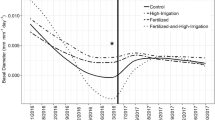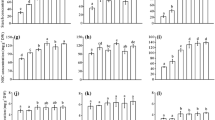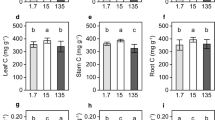Summary
Clones of 2 C4 grass species, Sprobolus ioclados and S. pyramidalis, were obtained from more and less heavily grazed grasslands, respectively, in Tanzania's Serengeti National Park. Plants were grown in a factorial experiment to determine the effects of severe defoliation, nutrient limitation, and a salivary chemical (thiamine) on plant growth, nitrogen content, and non-structural carbohydrate content. The experimental design included: (1) species; (2) clipping, with plants either unclipped or clipped weekly to a height of 5 cm; (3) 0.2 ml of distilled water of 0.2 ml of 10 ppb aqueous thiamine sprayed on plants from an atomizer after clipping and identical treatments at the same time to unclipped plants; (4) phosphorus (P) at 0.2 or 1 mM; (5) nitrogen (N) at 3 or 15 mM. Clipping was the major variable affecting plant growth. Total and litter yields were reduced to half and residual plant yield was reduced to 30% of the values for unclipped plants. Clipping interacted strongly with other variables since they commonly had minor effects on clipped plants and major effects on unclipped plants. Exceptions to this generalization were generally due to better performance by S. ioclados under clipping. Compared to lower treatment levels, higher treatment levels promoted total yield of unclipped plants by 52% for N, 43% for thiamine, and 33% for P. In general, thiamine had greater effects than P but lesser effects than N. Thiamine promoted yield and modified the chemical balance of plants by promoting carbohydrate (CHO) concentrations and reducing N concentrations. N and P deficiencies promoted CHO accumulation. Clipping promoted the N of leaves and crowns and reduced the N levels in roots. Leaf blade water and N contents were positively correlated with very little scatter. The slope of the line was different for S. ioclados and S. pyramidalis. Leaf blade water and CHO contents were negatively related but there was more scatter and the species could not be distinguished. The species from more heavily grazed grasslands was conspicuously more sensitive to thiamine application. The results indicated that leaf treatment with thiamine, the only likely source of which in natural grasslands is saliva deposited by feeding herbivores, can have major effects on plant yield and metabolic balances at very low application levels. But under defoliation levels as severe as those imposed in this experiment, which reduced above ground plant biomass to a fourth of the level produced by unclipped plants, growth was so strongly limited by defoliation that neither thiamine nor inorganic nutrients affected plant yield residual from clipping. Therefore, whether chemicals such as thiamine that may be introduced onto grass foliage by grazing ungulates and other herbivores will influence the growth of grazed plants will depend upon the grazing intensity associated with the transfer.
Similar content being viewed by others
References
Addicott FT (1941) Effects of root-growth hormones on the meristem of excised pea roots. Bot Gaz 102:576–581
Berger PJ, Negus NC, Sanders EH, Gardner PD (1981) Chemical triggering of reproduction in Microtus montanus. Science 214:69–70
Bergmann L, Bergmann AL (1968) Activierung der Biosynthese von Thiamin in Calluskulturen von Nicotiana tabacum im Licht. Planta 79:84–91
Bonner J (1937) Vitamin B1 a growth factor for higher plants. Science 85:183–184
Bonner J, Devirian PS (1939) Growth factor reqirements of four species of isolated roots. Am J Bot 26:661–665
Bonner J, Green J (1939) Further experiments on the relation of vitamin B1 to the growth of green plants. Bot Gaz 101:491–500
Clark D (1942) Influence of vitamin B1 on the growth of Agrostis tenuis and Brassica alba. Plant Physiol 17:137–140
Clayton WD, Phillips SM, Renvoize SA (1974) Flora of tropical east Africa. Graminae (Part 2). Crown Agents of Oversea Governments and Administrations. London, England
Cohen S (1962) Isolation of a mouse submaxillary gland protein accelerating incisor eruption and eyelid opening in the newborn animal. J Biol Chem 237:1555–1562
Cohen S (1965) The stimulation of epidermal proliferation by a specific protein. Dev Biol 12:394–407
Detling JK, Dyer MI, Procter-Gregg C, Winn DT (1980) Plantherbivore interactions: examination of potential effects of bison saliva on regrowth of Bouteloua gracilis (H.B.K.). Lag. Oecologia (Berlin) 45:26–31
Dyer MI (1980) Mammalian epidermal growth factor promotes plant growth. Proc Natl Acad Sci (USA) 77:4836–4837
Dyer MI, Bokhari UG (1976) Plant-animal interactions: studies of the effects of grasshopper grazing on blue grama grass. Ecology 57:762–772
Dyer MI, Detling JK, Coleman DC, Hilbert DW (1982) The role of herbivores in grasslands. In: Estes JR, Tyrl RJ, Brunken JN (eds). Grasses and grasslands. University of Oklahoma Press Norman, pp 255–295
Eisenberg JF (1981) The mammalian radiations. University of Chicago Press Chicago
Evans JR (1983) Nitrogen and photosynthesis in the flag leaf of wheat (Triticum aestivum L.). Plant Physiol 72:297–302
Field C (1983) allocating leaf nitrogen for the maximization of carbon gain: leaf age as a control on the allocation pattern. Oecologia (Berlin) 56:341–347
Field C, Mooney HA (1983) Leaf age and seasonal effects on light, water, and nitrogen use efficiency in a California shrub. Oecologia (Berlin) 56:348–355
Frazier WA, Boyd LF, Pulliam WM, Szutowicz A, Bradshaw RA (1974) Properties and specificity of binding sites for 125I nerve growth factor in embryonic heart and brain. J Biol Chem 249:5918–5923
Gray A, Dull TJ, Ullrich A (1983) Nucleotide sequence of epidermal growth factor cDNA predicts a 128,000-molecular weight precursor. Nature 303:722–725
Helwig JT (1978) SAS introductory guide. SAS Institute, Cary, North Carolina
Helwig JT, Council KA (1979) SAS user's guide. SAS Institute, Cary, North Carolina
Howe JG, Grant WE, Folse LJ (1982) Effects of grazing by Sigmodon hispidus on the regrowth of annual ryegrass (Lolium perene). J Mamm 63:176–179
Inoue M, Maeda E (1980) Thiamin as a factor of organ formation in rice callus cultures. Japan J Crop Sci 49:1–7
Johnston A, Bailey CD (1972) Influence of bovine saliva on grass regrowth in the greenhouse. Can J Anim Sci 52:573–574
Keast A, Erk RC, Glass B (1972) Evolution, mammals, and southern continents. State University of New York Press Albany
Laughlin RG, Munyon RL, Ries SK, Wert VF (1983) Growth enhancement of plants by femtomole doses of colloidally dispersed dispersed Triacontanol. Science 219:1219–1221
Leopold AS, Erwin M, Oh J, Browning B (1976) Phytoestrogens: adverse effect on reproduction in California quail. Science 191:98–100
Loumaye E, Thorner J, Catt KJ (1982) Yeast mating pheromone activates mammalian gonadotrophs: evolutionary conservation of a reproductive hormone? Science 218:1323–1325
Maddock L (1979) The “migration” and grazing succession. In: sinclair ARE, Norton-Griffiths M (eds). Serengeti: dynamics of an ecosystem. University of Chicago Press Chicago, pp 104–129
McDonald P, Edwards RA, Greenhalgh JFD (1973) Animal nutrition. Longman, London, England
McNaughton SJ (1976) Serengeti migratory wildebeest: facilitation of energy flow by grazing. Science 191:92–94
McNaughton SJ (1979a) Grazing as an optimization process: grass-ungulate relationships in the Serengeti. Am Nat 113:691–703
McNaughton SJ (1979b) Grassland-herbivore dynamics. In: Sinclair ARE, Norton-Griffiths M (eds). Serengeti: dynamics of an ecosystem. University of Chicago Press Chicago, pp 46–81
McNaughton SJ (1983) Serengeti grassland ecology: the role of composite environmental factors and contingency in community organization. Ecol Monogr 53:291–320
McNaughton SJ, Wallace LL, Coughenour MB (1983) Plant adaptation in an ecosystem context: effects of defoliation, nitrogen, and water on growth of an African C4 sedge. Ecology 64:307–318
Medina E (1971) Relationships between nitrogen level, photosynthetic capacity and carboxydismutase activity in Atriplex patula leaves. Carnegie Inst Wash Yearbook 69:655–662
Mooney HA, gulmon SL (1979) Environmental and evolutionary constraints on the photosynthetic characteristics of higher plants. In: Solbrig OT, Jain S, Johnson GB, Raven PH (eds). Topics in plant population biology. Columbia University Press New York, pp 316–337
Mooney HA, Gulmon SL (1982) Constraints on leaf structure and function in reference to herbivory. BioScience 32:198–206
Mooney HA, Field C, Gulmon SL, Bazzaz FA (1981) Photosynthetic capacity in relation to leaf position in desert versus oldfield annuals. Oecologia (Berlin) 50:109–112
Murdoch GH, Potter E, Nicolaisen AK, Evans RM, Rosenfeld MG (1982) Epidermal growth factor rapidly stimulates prolactin gene transcription. Nature 300:192–194
Negus JC, Berger PJ (1977) Experimental triggering of reproduction in a natural population of Microtus montanus. Science 196:1230–1231
Olsen P (1981) The stimulating effect of a phytohormone, gibberellic acid, on reproduction of Mus musculus. Aust J Wildl Res 8:321–325
Reardon PO, Merrill LB (1978) Response of sideoats grama grown in different soils to addition of thiamine and bovine saliva. Abstr First Internat Range Congr (Denver Colorado):37
Reardon PO, Leinweber CL, Merrill JLB (1972) The effect of bovine saliva on grasses. J Anim Sci 34:897–898
Reardon PO, Leinweber CL, Merrill JLB (1974) Response of sideoats grama to animal saliva and thiamine. J Range Manage 27:400–401
Robbins WJ, Bartley MA (1937) Vitamin B1 and the growth of excised tomato roots. Science 85:246–247
Sanders EH, Gardner PD, Berger PJ, Negus NC (1981) 6-methoxybenzoxazo-linone: a plant derivative that stimulates reproduction in Microtus montanus. Science 214:67–69
Scott WB (1937) A history of land mammals in the Western Hemisphere. Macmillan New York
Simpson GG (1951) Horses. Oxford University Press, New York
Smith D (1969) Removing and analyzing total nonstructural carbohydrates from plant tissues. University of Wisconsin (Madison) Report No. 41:1–11
Sporn MB, Roberts AB, Shull JH, Smith JM, Ward JW, Sodek J (1983) Polypeptide transforming growth factors isolated from bovine sources and used for wound healing in vivo. Science 219:1329–1331
Vittoria A, Rendina N (1960) Fattori condizionanti la funzionalita tiaminica in piante superiori e cenni sugli effetti dell bocca dei runinanti sull erbe pascolative. Acta Medica Vet (Naples) 6:379–405
Webb SD (1977) A history of savanna vertebrates in the new world. Part I. North America. Ann Rev Ecol Syst 8:355–380
Webb SD (1978) A history of savanna vertebrates in the new world. Part II. South America and the great interchange. Ann Rev Ecol Syst 9:393–426
Author information
Authors and Affiliations
Rights and permissions
About this article
Cite this article
McNaughton, S.J. Interactive regulation of grass yield and chemical properties by defoliation, a salivary chemical, and inorganic nutrition. Oecologia 65, 478–486 (1985). https://doi.org/10.1007/BF00379660
Received:
Issue Date:
DOI: https://doi.org/10.1007/BF00379660




